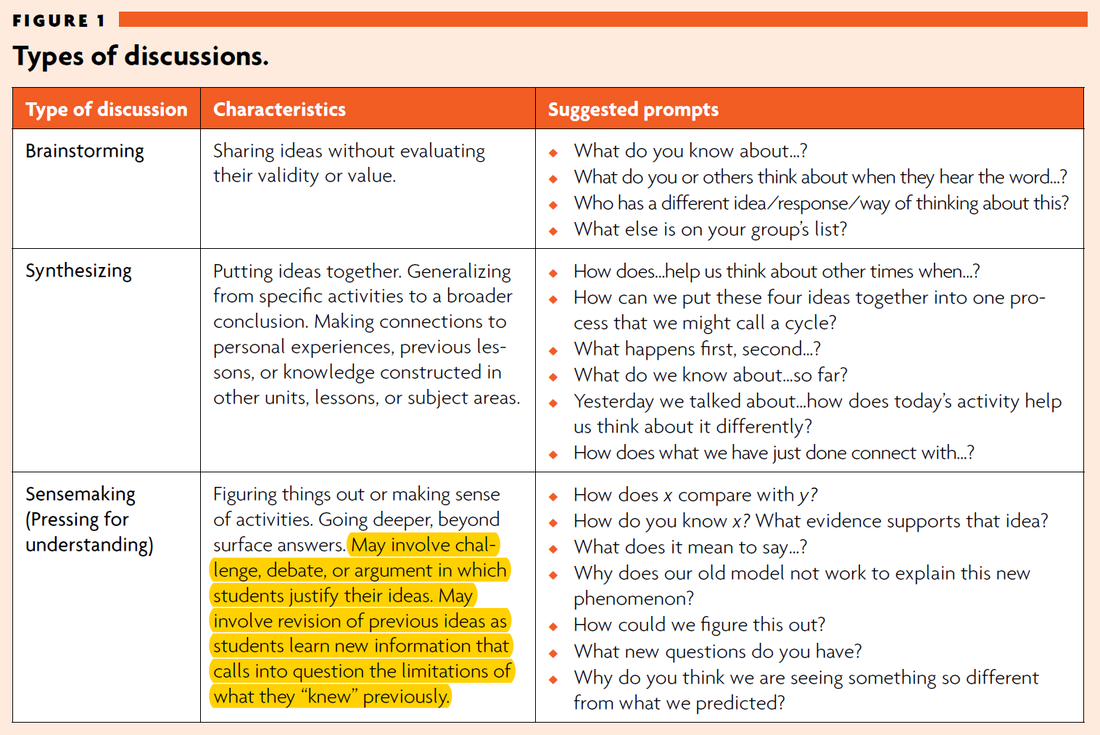- Blog
-
THESIS
- MISSION: Learning science by doing science.
- ARGUMENTATION: The missing piece to inquiry.
- IMPLEMENTATION: Teaching students to think like scientists
- FINDINGS: Student growth and response to argumentation frameworks
- REFLECTION: Co-generative thoughts for future practice
- ARTIFACTS: Data from the field and the study
- Portfolio
- About
|
In my ideal classroom, students are deep in discussion. They’re sharing ideas, investigating problems, and formulating arguments to solve meaningful inquiries. This mirrors the work that real scientists do! In addition to learning about interesting phenomena, they’re also collaborating to evaluate the science behind the phenomena, and the methodology within the science. In my goal of fostering creative thinkers and problem-solvers, I want to train students in the skill of argumentation. This means they need to generate, challenge, and justify their ideas. And it works best when students are engaged in authentic discourse. However… traditional science education is often devoid of such discussion. Typically, teachers tend to fall back onto what Yael Shwartz calls IRE dialogues: “the teacher initiates a question, a student responds, and the teacher immediately evaluates whether the answer is correct or incorrect” (Shwartz et al 2009). Whereas this method is quick and effective for moving a class through a lesson, it is very much teacher-centered. “The teacher,” Shwartz continues, “[is placed at] center stage, and students’ questions and their learning in the background.” So what should authentic discourse look like? Shwartz et al identify three main types of discussion: brainstorming, in which students share ideas non-judgmentally; synthesizing, in which students connect ideas across activities; and sensemaking, in which students refine their ideas through argumentation and evaluation. I’m particularly interested in sensemaking discussion, as this is the final step where learning is at its deepest. This is when students actually figure things out! Shwartz et al outline this further in the figure below. Note the highlighting as well (emphasis mine). Since argumentation is such a significant part of this pressing for understanding, this may be a perfect opportunity for students to revisit CER. I recently saw an opportunity for sensemaking discussion in the classroom. In a lab investigation on passive transport, students were tasked to explore relationships between surface area, volume, and diffusion rates in agar cubes. In another section of the lab, they were also instructed to investigate osmosis occurring across a semipermeable dialysis bag. This experience was not particularly student-centered, as students were following pre-dictated instructions rather than coming up with their own inquiries. As a result, though they were somewhat engaged throughout the activity, I didn’t feel that they were completely present in driving their learning forward. Formative assessment drop-ins confirmed this: they were following the recipe, but they didn’t understand the cooking. So, the next day I implemented some argumentation exercises. We reviewed our experimental set-ups, objectives, and scientific concepts. Why did we use dialysis bags? To represent semipermeable membranes? OK, check. What’s osmosis again? The diffusion of water across a membrane? OK, check. Good: we had a consensus regarding basic learning objectives. But could we successfully explain what was happening in our investigations? I handed each table a whiteboard, and instructed students that we’d be using CER once again. This time, the goal was to make sense of what we saw in the lab. I offered some scaffolding, using water permeability as an example. Were our dialysis bags permeable to water? Here’s what I wrote: Claim: Yes, the dialysis bags were permeable to water. Evidence: After placing a dialysis bag into a beaker of water, we observed that the bag increased in mass from 33 to 41 grams. (Note: I wasn’t using actual data here. This was a nod to the big Eagles win!) We also noticed that the bag increased in volume, becoming more turgid. Reasoning: Since water was the only solution surrounding the dialysis bags, it must be water that contributed to the increase in mass. Therefore, water can pass through the material of the bag. How did the students do? Responses were variable in nature. Some failed to use CER at all… which was concerning. And others cited scientific concepts or assumptions as evidence, which remains a common gap in logic. But most groups successfully cited evidence from their investigations. And they gave solid reasoning to tie scientific principles back to their claims! Compared to our first time trying out CER, this is a marked improvement. Another benefit: While students were at work, I was also able to circulate throughout the room to give feedback on their arguments. I like this whiteboard method for this reason in particular – I can quickly and easily see students’ thinking, and correct it appropriately. When one group said starch was too big to pass through the bag, for example, I was able to reply How do you know?--and redirect their argumentation towards another solution. In future sessions, hopefully they'll be able to ask themselves these questions. :)
We still have more work to do regarding argumentation. It’s a skill that will need to be incorporated regularly. But, with practice, I’m optimistic that we will continue to improve. And, with time, our discussions will be more and more productive!
2 Comments
|
AuthorHi! I'm a bio/chem teacher and M.S.Ed. student at the University of Pennsylvania. Archives
April 2018
Categories |
Proudly powered by Weebly



